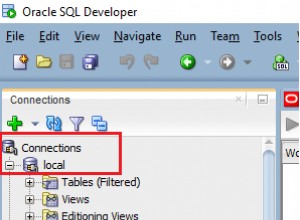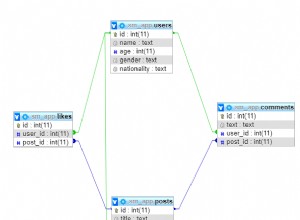Questo articolo è la parte 2 di una serie in due parti che descrive i passaggi per l'impostazione di Active Data Guard Physical Standby in RAC One Node Architecture. Puoi trovare la parte 1 qui.
1. Al termine del processo di duplicazione del database (Parte 1 dell'articolo), aggiungere il database Standby in Clusterware
srvctl add database -d analytics_dg -o /u01/app/oracle/product/12.1.0.2/dbhome_1 -c RACONENODE -p '+DG_DATA/analytics_DG/PARAMETERFILE/spfileanalytics_dg.ora' -r PHYSICAL_STANDBY -s MOUNT -n analytics_dg -e hostdr
2. chiudere un database
sqlplus> shutdown immediate;
3. Copia "Oracle password file" con il nuovo nome di istanza "orapwanalyticsdg_1"
cd $ORACLE_HOME/dbs cp orapwanalytics_dg orapwanalyticsdg_1
4. Avvia database
$ srvctl start database -d analytics_dg $ srvctl config database -d analytics_dg Database unique name: analytics_dg Database name: analytics_dg Oracle home: /u01/app/oracle/product/12.1.0.2/dbhome_1 Oracle user: oracle Spfile: +DG_DATA/analytics_DG/PARAMETERFILE/spfileanalytics_dg.ora Password file: Domain: Start options: read only Stop options: immediate Database role: PHYSICAL_STANDBY Management policy: AUTOMATIC Server pools: Disk Groups: DG_DATA,DG_RECO Mount point paths: Services: Type: RACOneNode Online relocation timeout: 30 Instance name prefix: analyticsdg Candidate servers: hostdr OSDBA group: sdba OSOPER group: soper Database instances: Database is administrator managed
5. Secondo il modello di Oracle Restart, l'istanza analytics_dg sarà chiamata analyticsdg_1, pertanto listener.ora deve essere aggiornato.
Esegui il comando "listener reload" per forzare l'ascoltatore a leggere nuovamente le voci "listener.ora". Attenzione! Questa operazione influirà sulla disponibilità dell'ascoltatore.
SID_LIST_LISTENER = (SID_LIST = (SID_DESC = (GLOBAL_DBNAME = analytics_dg_dgmgrl) # (SID_NAME = analytics_dg) (SID_NAME = analyticsdg_1) (ORACLE_HOME = /u01/app/oracle/product/12.1.0.2/dbhome_1) ) )
6. Redo Transport Service verrà abilitato manualmente per convalidare connessioni e impostazioni.
Parametri DB_BLOCK_CHECKSUM , DB_BLOCK_CHECKING e DB_LOST_WRITE_PROTECT verrà configurato per entrambi i database, primario e standby, per prevenire e rilevare i blocchi danneggiati.
6.1. Regola i parametri nel database di standby
sqlplus> alter system set log_archive_config='dg_config=(analytics,analytics_dg)' scope=both sid='*' ; sqlplus> alter system SET log_archive_dest_1='LOCATION=USE_DB_RECOVERY_FILE_DEST VALID_FOR=(ALL_ROLES, ALL_LOGFILES) db_unique_name=analytics_dg' scope=both sid='*' ; sqlplus> alter system set log_archive_dest_2='service=analytics LGWR ASYNC NOAFFIRM max_failure=10 max_connections=1 reopen=180 valid_for=(online_logfiles,primary_role) db_unique_name=analytics' scope=both sid='*'; sqlplus> alter system set fal_server='analytics' scope=both sid='*'; sqlplus> alter system set fal_client='analytics_dg' scope=both sid='*'; sqlplus> alter system set log_archive_max_processes=4 scope=both sid='*'; sqlplus> alter system set standby_file_management='AUTO' scope=both sid='*'; sqlplus> alter system set db_file_name_convert='+DG_DATA_DR/analytics','+DG_DATA/analytics_DG','+DG_RECO_DR/analytics','+DG_RECO/analytics_DG' scope=spfile sid='*'; sqlplus> alter system set log_file_name_convert='+DG_DATA_DR/analytics','+DG_DATA/analytics_DG','+DG_RECO_DR/analytics','+DG_RECO/analytics_DG' scope=spfile sid='*'; sqlplus> alter system set db_block_checksum=FULL scope=both sid='*' ; sqlplus> alter system set db_block_checking=MEDIUM scope=both sid='*' ; sqlplus> alter system set db_lost_write_protect=TYPICAL scope=both sid='*' ; sqlplus> alter system set log_archive_dest_state_1='enable' scope=both sid='*'; sqlplus> alter system set log_archive_dest_state_2='enable' scope=both sid='*';
6.2. Regola i parametri nel database primario:
sqlplus> alter system set log_archive_config='dg_config=(analytics,analytics_dg)' scope=both sid='*' ; sqlplus> alter system SET log_archive_dest_1='LOCATION=USE_DB_RECOVERY_FILE_DEST VALID_FOR=(ALL_ROLES,ALL_LOGFILES) db_unique_name=analytics' scope=both sid='*' ; sqlplus> alter system set log_archive_dest_2='service=analytics_dg LGWR ASYNC NOAFFIRM max_failure=10 max_connections=1 reopen=180 valid_for=(online_logfiles,primary_role) db_unique_name=analytics_dg' scope=both sid='*'; sqlplus> alter system set fal_server='analytics_dg' scope=both sid='*'; sqlplus> alter system set fal_client='analytics' scope=both sid='*'; sqlplus> alter system set log_archive_max_processes=4 scope=both sid='*' ; sqlplus> alter system set standby_file_management='AUTO' scope=both sid='*' ; sqlplus> alter system set db_file_name_convert='+DG_DATA/analytics_DG','+DG_DATA_DR/analytics','+DG_RECO/analytics_DG','+DG_RECO_DR/analytics' scope=spfile sid='*'; sqlplus> alter system set log_file_name_convert='+DG_DATA/analytics_DG','+DG_DATA_DR/analytics','+DG_RECO/analytics_DG','+DG_RECO_DR/analytics' scope=spfile sid='*'; sqlplus> alter system set db_block_checksum=TYPICAL scope=both sid='*' ; sqlplus> alter system set db_block_checking=MEDIUM scope=both sid='*' ; sqlplus> alter system set db_lost_write_protect=TYPICAL scope=both sid='*' ; sqlplus> alter system set log_archive_dest_state_1='enable' scope=both sid='*' ; sqlplus> alter system set log_archive_dest_state_2='enable' scope=both sid='*' ;
6.3. L'attributo "status" di Primary e Standby deve restituire "VALID"
sqlplus> select dest_id,status,destination ,error from v$archive_dest where dest_id <=5; ID DB_status Archive_dest Error ---------- --------- ----------------------------- ------- 1 VALID USE_DB_RECOVERY_FILE_DEST 2 VALID analytics_dg 3 INACTIVE 4 INACTIVE 5 INACTIVE sqlplus> select dest_id,status,database_mode,recovery_mode from v$archive_dest_status where status <> 'INACTIVE'; DEST_ID STATUS DATABASE_MODE RECOVERY_MODE ---------- --------- --------------- ----------------------- 1 VALID OPEN IDLE 2 VALID MOUNTED-STANDBY IDLE
6.4. Avvia manualmente Ripeti Applica:
sqlplus> alter database recover managed standby database using current logfile disconnect;
6.5. Sincronizzazione tra la convalida del database primario e di standby
sqlplus> select * from v$archive_gap; sqlplus> select name, value, datum_time, time_computed from v$dataguard_stats where name like 'apply lag'; sqlplus> select file_type, number_of_files, percent_space_used from v$recovery_area_usage; sqlplus> select current_scn from v$database; sqlplus> select sequence#, first_time, applied from v$archived_log order by sequence#;
6.6. Interrompi Ripeti Applica prima di configurare Data Guard Broker
sqlplus> alter database recover managed standby database cancel; Database altered.
7. Configura Data Guard Broker nel database primario e in standby
Nota:i file di impostazione di Data Guard verranno creati in ASM in diversi diskgroup:dg_broker_config_file1 e dg_broker_config_file2
7.1. Nel database primario:
sqlplus> alter system set dg_broker_config_file1 = '+DG_DATA_DR/analytics/BROKERCFG/brokeranalytics1.dat' scope=both sid='*'; sqlplus> alter system set dg_broker_config_file2 = '+DG_RECO_DR/analytics/BROKERCFG/brokeranalytics2.dat' scope=both sid='*'; sqlplus> alter system set log_archive_dest_2='' scope=both sid='*' ; sqlplus> alter system set DG_BROKER_START=FALSE scope=both sid='*'; sqlplus> alter system set DG_BROKER_START=TRUE scope=both sid='*';
7.2. Nel database di standby:
sqlplus> alter system set dg_broker_config_file1 = '+DG_DATA/analytics_DG/BROKERCFG/brokeranalytics_dg1.dat' scope=both sid='*'; sqlplus> alter system set dg_broker_config_file2 = '+DG_RECO/analytics_DG/BROKERCFG/brokeranalytics_dg2.dat' scope=both sid='*'; sqlplus> alter system set log_archive_dest_2='' scope=both sid='*' ; sqlplus> alter system set DG_BROKER_START=FALSE scope=both sid='*'; sqlplus> alter system set DG_BROKER_START=TRUE scope=both sid='*';
7.3. Impostazioni del broker:
$ dgmgrl dgmgrl> connect sys/xxxxx@analytics Connected as SYSDBA. dgmgrl> create configuration 'analytics_cfg' as primary database is 'analytics' connect identifier is analytics; Configuration "analytics_cfg" created with primary database "analytics" dgmgrl> add database 'analytics_dg' as connect identifier is analytics_dg maintained as physical; Database "analytics_dg" added dgmgrl> edit database 'analytics_dg' set property logxptmode=async; Property "logxptmode" updated dgmgrl> edit configuration set protection mode as MAXPERFORMANCE; Succeeded. dgmgrl> enable configuration; Enabled.
Usa il comando MOSTRA CONFIGURAZIONE per mostrare un breve riepilogo delle impostazioni.
dgmgrl> show configuration Configuration - analytics_cfg Protection Mode: MaxPerformance Databases: analytics - Primary database analytics_dg - Physical standby database Fast-Start Failover: DISABLED Configuration Status: SUCCESS
7.4. Convalida le impostazioni con i comandi
dgmgrl> show database verbose 'analytics_dg' 'RecvQEntries'; dgmgrl> show database verbose 'analytics'; dgmgrl> show database verbose 'analytics_dg';
Nodo 1:
sqlplus> select NAME,OPEN_MODE,PROTECTION_MODE,PROTECTION_LEVEL,DATABASE_ROLE from v$database; NAME OPEN_MODE PROTECTION_MODE PROTECTION_LEVEL DATABASE_ROLE --------- -------------------- -------------------- -------------------- ----------- analytics READ WRITE MAXIMUM PERFORMANCE MAXIMUM PERFORMANCE PRIMARY
Nodo 2:
sqlplus> select NAME,OPEN_MODE,PROTECTION_MODE,PROTECTION_LEVEL,DATABASE_ROLE from v$database; NAME OPEN_MODE PROTECTION_MODE PROTECTION_LEVE DATABASE_ROLE --------- -------------------- -------------------- -------------------- ----------- analytics READ WRITE MAXIMUM PERFORMANCE MAXIMUM PERFORMANCE PRIMARY
Standby DB:
sqlplus> select NAME,OPEN_MODE,PROTECTION_MODE,PROTECTION_LEVEL,DATABASE_ROLE from v$database; NAME OPEN_MODE PROTECTION_MODE PROTECTION_LEVEL DATABASE_ROLE --------- ---------------- -------------------- -------------------- ---------------- analytics MOUNTED MAXIMUM PERFORMANCE MAXIMUM PERFORMANCE PHYSICAL STANDBY
8. Le regolazioni su Broker verranno apportate alle impostazioni "MaxConnections", "TransportDisconnectedThreshold" e "TransportLagThreshold" [1]
La proprietà "MaxConnections" specifica quanti processi ARCn verranno utilizzati in parallelo per trasferire i dati da un file di registro di ripristino al sito remoto quando è presente un GAP nel processo. Se MaxConnections è definito con un valore maggiore di 1, i servizi di trasporto di ripristino utilizzano più processi ARCn per trasferire i dati da un file di registro di ripristino allo standby.
La proprietà "TransportDisconnectedThreshold" può essere utilizzata per creare uno stato di avviso per un'attesa logica o fisica o un'acquisizione istantanea quando l'ultima comunicazione del database primario supera il valore specificato della proprietà. Il valore della proprietà è espresso in secondi.
La proprietà "TransportLagThreshold" può essere utilizzata per creare uno stato di avviso per un'attesa logica o fisica o per l'acquisizione istantanea quando il ritardo di trasporto del database supera il valore specificato della proprietà. Il valore della proprietà è espresso in secondi.
dgmgrl> edit database 'analytics' SET PROPERTY 'MaxConnections'= 4; Property "MaxConnections" updated dgmgrl> edit database 'analytics' SET PROPERTY TransportDisconnectedThreshold='180'; Property "transportdisconnectedthreshold" updated dgmgrl> edit database 'analytics' SET PROPERTY TransportLagThreshold='900'; Property "transportlagthreshold" updated dgmgrl> edit database 'analytics_dg' SET PROPERTY 'MaxConnections'= 4; Property "MaxConnections" updated dgmgrl> edit database 'analytics_dg' SET PROPERTY TransportDisconnectedThreshold='180'; Property "transportdisconnectedthreshold" updated dgmgrl> edit database 'analytics_dg' SET PROPERTY TransportLagThreshold='900'; Property "transportlagthreshold" updated
9. Modificare gli archivi dei criteri di esclusione nel database primario.
rman> CONFIGURE ARCHIVELOG DELETION POLICY TO SHIPPED TO STANDBY;
Attivazione di Dataguard attiva
10. Interrompi Ripeti Applica nel broker
$ dgmgrl dgmgrl> connect sys dgmgrl> edit database 'analytics_dg' set state = 'apply-off'; dgmgrl> show database 'analytics_dg'
11. Apri l'istanza di standby in modalità di sola lettura.
sqlplus> alter database open read only;
12. Avvia Ripeti Applica nel broker
$ dgmgrl dgmgrl> connect sys dgmgrl> edit database 'analytics_dg' set state = 'apply-on'; dgmgrl> show database 'analytics_dg'
Riferimenti
[1] Broker di protezione dei dati. Disponibile su:https://docs.oracle.com/cd/E11882_01/server.112/e40771/dbpropref.htm#DGBKR3781




